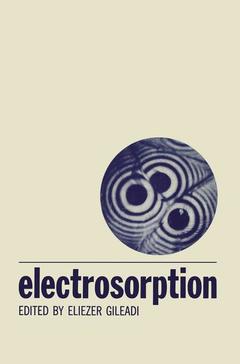Electrosorption, Softcover reprint of the original 1st ed. 1967
Langue : Anglais
Coordonnateur : Gileadi Eliezer

The gradual emergence during the last decade of the study of the mechanism of electrode reactions from the dark ages has given stimulus to a consideration of the double layer at metal-solution interfaces, which extends far outside the classical experimental studies of the capacitance of the mercury solution interface made during the 1950's by D. C. Grahame at Amherst College, Massachusetts. The central aspect of the study of an electrode reaction is the elucidation of its path and rate-determining step. Two fields are, however, prerequisites for such studies. First, it must be known what species are in the bulk of the solution, for these will seldom be simple ones such as H30~ and this study ("complex ions") has been made with both extent and depth. Second, the occupancy of the surface of the electrocatalyst and the associated field gradients must be known as a function of position in the double layer. Such "maps of the double layer" can be given with reasonable certainty up to concentrations of about 1 N for mercury in contact with solutions of inorganic ions. However, this is-or was until very recently-the extent of the know ledge. The problems confronting a fundamental approach to the rational development of, e.g., fuel cell catalysis were therefore considerable.
I Adsorption in Electrochemistry.- 1. Introduction.- 2. Equations of State and Isotherms.- 3. The Langmuir Isotherm.- 4. The Temkin Isotherm.- 5. The Frumkin Isotherm.- 6. Experimental Tests of the Isotherms.- 7. Conclusions.- References.- 2 Organic Adsorption at Electrodes.- 1. Introduction.- 2. Comparison of Methods for Adsorption Studies in the Gas Phase and at Electrodes in Solution.- 3. Energetics of Adsorption.- 4. Trends in Electrosorption.- 5. Modes of Adsorption and Structure of Adsorbed Species.- 6. The Adsorption Characteristics of Some Selected Compounds.- 7. Open-Circuit Adsorption Behavior.- 8. Summary.- References.- 3 Kinetics of Diffusion-Controlled Electrosorption of Neutral Molecules.- 1 Introduction.- 2. The Adsorption Isotherm and the Mass Transfer Process.- 3. Analysis of the Diffusion Problem.- 4. The Time Variation of the Surface Concentration of Adsorbed Species.- 5. Mass Transport-Controlled Electrosorption Under Stirred Conditions.- References.- 4 Oxygen Adsorption and Oxide Formation on Electrodes.- 1. Introduction.- 2. Thermodynamics of Oxidation.- 3. Characteristics of Physically Adsorbed Oxygen.- 4. Characteristics of Chemisorbed Oxygen.- 5. The Occurrence of Physical Adsorption.- 6. The Occurrence of Chemisorption.- 7. Mechanism of Oxide Growth.- 8. Why is Adsorbed Oxygen Important ?.- References.- 5 The Potential of Zero Charge.- 1. Introduction.- 2. Aspects of the Potential of Zero Charge Dependent on the Metal.- 3. Aspects of the Potential of Zero Charge Related to the System.- 4. Methods of Determination of the Potential of Zero Charge.- 5. Conclusions.- References.- 6 The Role of Solvents at Electrodes.- 1. Introduction.- 2. Field-Dependent Orientation of the Solvent at the Metal—Solution Interface.- 3. Dielectric Properties of theSolvent at the Electrode.- 4. Adsorptive Properties of the Solvent at the Electrode.- 5. Final Remarks.- References.- 7 Theoretical Consideration of the Double Layer.- 1. An Electrostatic Model of the Electrochemical Double Layer.- 2. The Local Thermodynamic Formulation for Inhomogeneous Electrochemical Systems.- 3. Theories of the Ionic Double Layer.- References.
Date de parution : 03-2012
Ouvrage de 222 p.
15.2x22.9 cm
Thème d’Electrosorption :
Mots-clés :
Atom; Diffusion; Langmuir; Sorption; adsorption; catalysis; catalyst; electrochemistry; electrolyte; fields; fuel cell; kinetics; metals; structure; thermodynamics
© 2024 LAVOISIER S.A.S.



